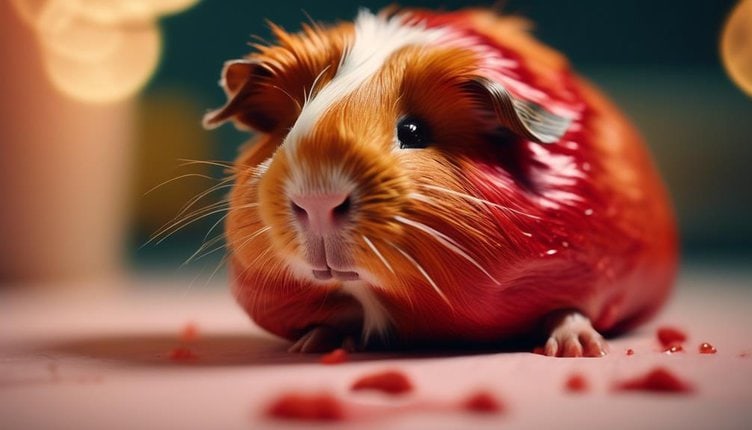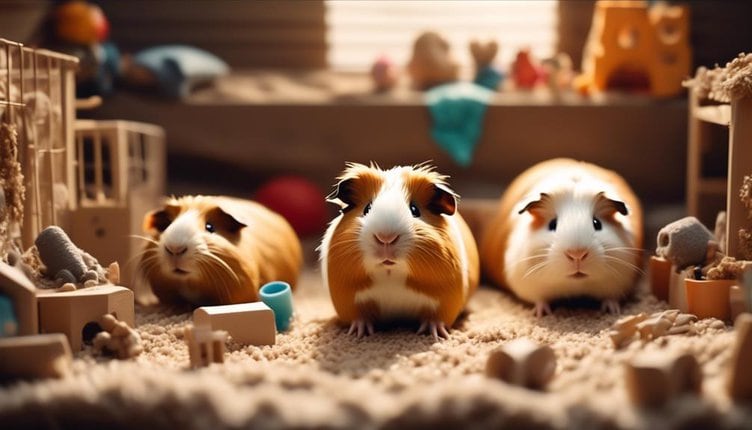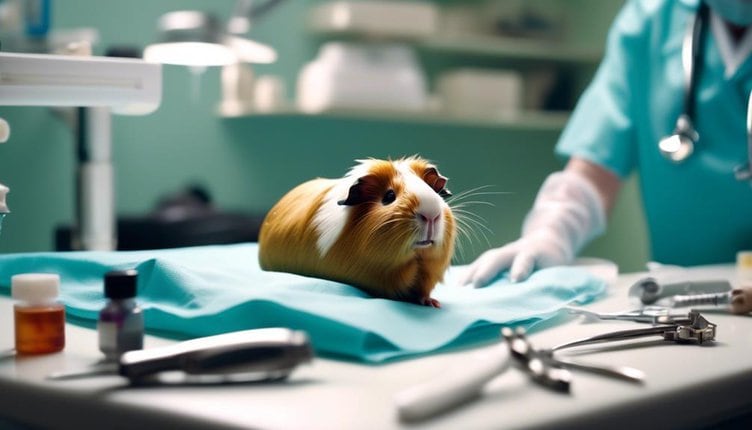Hey there, have you ever wondered why guinea pigs get pododermatitis? It's this thing called bumblefoot and it can really cause some discomfort and pain for these cute little pets.
But here's the deal, what actually causes it and how can we prevent it? Well, let's dive into that and get you some practical tips on how to keep your guinea pig's feet in tip-top shape.
By understanding the causes and taking preventive measures, you can ensure your furry friends have a super happy and comfortable life.
So, let's jump right into the world of pododermatitis and discover how to keep those adorable paws healthy and happy.
Key Takeaways
- Pododermatitis, also known as bumblefoot, is inflammation and infection of the foot pads in guinea pigs.
- Excessive pressure and friction on the foot pads from hard or abrasive surfaces can cause pododermatitis.
- Poor hygiene, such as dirty and damp bedding, creates a breeding ground for bacteria and fungi.
- Providing a suitable environment with solid flooring and soft, absorbent bedding is crucial for preventing pododermatitis.
Understanding Pododermatitis
Pododermatitis, also known as bumblefoot, is a common condition in guinea pigs caused by inflammation and infection of the foot pads. Understanding the prevention measures and treatment options for this condition is essential for those who desire to serve and care for these small pets.
Prevention is key when it comes to pododermatitis in guinea pigs. One of the most important measures is to provide a clean and comfortable living environment. Regularly cleaning the cage and removing any sharp objects or rough surfaces that could cause injury to the foot pads is crucial. Additionally, ensuring that the guinea pig has access to a soft bedding material, such as fleece or shredded paper, can help reduce the risk of developing bumblefoot.
In terms of treatment options, early detection is crucial. If a guinea pig is showing signs of pododermatitis, it's important to seek veterinary care promptly. A veterinarian will be able to assess the severity of the condition and recommend appropriate treatment. This may include cleaning the affected area, administering antibiotics to treat any infection, and providing pain relief medication if necessary. In some cases, surgery may be required to remove any abscesses or damaged tissue.
Common Causes of Pododermatitis in Guinea Pigs
One of the primary causes of pododermatitis in guinea pigs is excessive pressure and friction on the foot pads. This occurs when guinea pigs are kept on hard or abrasive surfaces for extended periods of time. Wire-bottomed cages, rough bedding materials, or inadequate bedding can contribute to the development of pododermatitis. It's important to provide guinea pigs with a suitable environment that minimizes pressure and friction on their foot pads.
Another common cause of pododermatitis is poor hygiene. Dirty and damp bedding can create a breeding ground for bacteria and fungi, leading to infections and skin irritation. Regular cleaning and disinfection of the cage, as well as providing clean and dry bedding, can help prevent the development of pododermatitis.
Additionally, improper diet and obesity can contribute to the development of pododermatitis. A diet lacking in essential nutrients, such as vitamin C, can lead to weakened foot pads and skin. Obesity puts additional pressure on the foot pads and can exacerbate the condition.
In terms of treatment options for pododermatitis, it's important to address the underlying causes. Providing a suitable environment with soft bedding and a clean cage is crucial. Regularly cleaning and disinfecting the cage can help prevent infections. Additionally, ensuring a balanced and nutritious diet can promote the overall health of guinea pigs and aid in the healing process. In severe cases, veterinary intervention may be necessary, which may involve medication, wound care, and possible surgical intervention.
Recognizing the Symptoms of Pododermatitis

Recognizing the symptoms of pododermatitis involves observing the guinea pig's foot pads for signs of redness, swelling, sores, or scabs. Pododermatitis, also known as bumblefoot, is a common condition in guinea pigs that affects their foot pads. It often occurs due to the pressure exerted on the foot pads when the guinea pig spends prolonged periods on hard or abrasive surfaces.
When examining a guinea pig's foot pads, it's important to look for any changes in color or texture. Redness and swelling are common signs of inflammation, indicating that pododermatitis may be present. Additionally, the presence of sores or scabs on the foot pads may indicate that the condition has progressed to a more severe stage.
Preventing pododermatitis is crucial for the wellbeing of guinea pigs. One way to prevent this condition is by providing them with appropriate bedding materials such as fleece or soft towels, which help to cushion their feet. Regularly cleaning the cage and ensuring that it's free from sharp objects or rough surfaces can also minimize the risk of pododermatitis.
Treatment options for pododermatitis may vary depending on the severity of the condition. Mild cases can often be managed by cleaning the affected foot pads with a mild antiseptic solution and applying a topical antibiotic ointment. In more severe cases, it may be necessary to consult a veterinarian who can provide further treatment options such as oral antibiotics or surgical intervention.
Importance of Proper Hygiene and Cage Maintenance
Proper hygiene and cage maintenance are essential for preventing pododermatitis and ensuring the overall health and well-being of guinea pigs. Maintaining a clean and hygienic living environment is crucial in preventing the development of pododermatitis, a painful condition that affects the feet of guinea pigs.
Regular and proper cleaning of the cage is necessary to eliminate the accumulation of urine, feces, and bedding material that can cause bacterial and fungal infections.
To maintain a clean cage, it's important to establish a proper cleaning routine. This includes removing any soiled bedding daily and replacing it with fresh bedding. Additionally, spot cleaning should be done regularly to remove any urine or feces that may have soiled the cage floor or accessories.
Thorough cleaning of the cage should be done at least once a week, where all objects, such as hideouts, toys, and food bowls, should be washed with mild soap and water. The cage itself should also be cleaned using a pet-safe disinfectant to eliminate any potential pathogens.
In addition to proper cleaning, the cage setup plays a significant role in preventing pododermatitis. Guinea pigs require a spacious cage with solid flooring to avoid pressure sores. Wire-bottomed cages should be avoided as they can cause foot injuries. Providing a soft and absorbent bedding material, such as fleece or paper bedding, can also help cushion their feet and prevent skin irritation.
Providing a Comfortable Living Environment

To ensure optimal well-being and prevent the development of pododermatitis, it is crucial to create a comfortable living environment for guinea pigs. This includes providing appropriate bedding and following a regular cleaning schedule.
One of the key factors in maintaining a comfortable living environment for guinea pigs is choosing the right bedding. Guinea pigs have sensitive feet, so it is important to avoid bedding materials that can cause irritation or injury. Good options for bedding include fleece, paper-based products, and aspen shavings. These materials provide a soft and comfortable surface for the guinea pigs to walk on, reducing the risk of pododermatitis.
In addition to choosing appropriate bedding, it is essential to establish a regular cleaning schedule. Guinea pig cages should be cleaned at least once a week, or more frequently if needed. This involves removing soiled bedding, wiping down the cage, and replacing with fresh bedding. Regular cleaning not only helps to prevent the buildup of bacteria and odors, but it also ensures a clean and hygienic living environment for the guinea pigs.
By providing a comfortable living environment with appropriate bedding and following a regular cleaning schedule, guinea pig owners can significantly reduce the risk of pododermatitis and promote the overall well-being of their furry friends.
| Bedding Material | Pros | Cons |
|---|---|---|
| Fleece | Soft and cozy | Requires frequent washing |
| Paper-based | Dust-free | May need more frequent changes |
| Aspen shavings | Natural and absorbent | Can be messy |
Feeding a Balanced Diet for Guinea Pig Health
A balanced diet is essential for maintaining optimal health in guinea pigs. Proper nutrition plays a crucial role in preventing various health problems and ensuring their overall well-being. Here are three important aspects of guinea pig nutrition to consider:
- Hay: Guinea pigs require a constant supply of high-quality grass hay, such as timothy or orchard grass. Hay is a vital component of their diet as it helps wear down their continuously growing teeth, prevents dental problems, and aids in proper digestion.
- Fresh Vegetables: Guinea pigs should be fed a variety of fresh vegetables daily. Leafy greens like romaine lettuce, spinach, and kale are excellent sources of vitamins and fiber. Other vegetables, such as bell peppers, carrots, and cucumbers, can also be included to provide additional nutrients.
- Pellets: Guinea pig-specific pellets should be given in moderation, as they contain essential nutrients like vitamin C, which is crucial for their health. However, pellets shouldn't be the main component of their diet, as an excessive intake can lead to obesity and other health issues.
It is essential to consult a veterinarian or a knowledgeable guinea pig care resource to ensure that the dietary requirements of these adorable pets are met. By providing a balanced diet, guinea pig owners can contribute to the overall health and well-being of their furry companions.
Regular Veterinary Check-ups and Care

Regular veterinary check-ups and care are crucial for ensuring the overall health and well-being of guinea pigs, complementing their balanced diet and nutrition. These regular check-ups play a vital role in preventive care, allowing veterinarians to detect any potential health issues early on and provide appropriate treatment. Guinea pigs are prone to various health problems, such as dental issues, respiratory infections, and skin conditions. Through regular check-ups, veterinarians can assess the guinea pig's general health and address any concerns promptly.
During a check-up, the veterinarian will conduct a thorough physical examination of the guinea pig, checking its eyes, ears, teeth, skin, and overall body condition. They may also perform additional tests, such as blood work or fecal examinations, to further evaluate the guinea pig's health. These tests can help identify underlying health conditions that may not be immediately apparent.
In addition to regular check-ups, guinea pigs require routine care to maintain their well-being. This includes keeping their habitat clean and providing proper nutrition and exercise. Regular nail trims are also necessary to prevent overgrowth and potential injuries. Owners should closely monitor their guinea pigs for any changes in behavior, appetite, or appearance and seek veterinary care promptly if any concerns arise.
Frequently Asked Questions
Can Guinea Pigs Get Pododermatitis From Walking on Different Surfaces?
Guinea pigs can develop pododermatitis if they walk on different surfaces that are hard or abrasive. Proper guinea pig foot care, such as providing soft bedding and regular nail trimming, can help prevent this condition.
Can Pododermatitis Be Contagious to Other Guinea Pigs?
Pododermatitis in guinea pigs is not contagious to other guinea pigs or humans. The symptoms of pododermatitis in guinea pigs include redness, swelling, and ulceration of the footpads.
Are There Any Specific Breeds of Guinea Pigs That Are More Prone to Developing Pododermatitis?
Some guinea pig breeds may have a higher likelihood of developing pododermatitis due to differentiating factors in their genetics. However, the impact of the environment on pododermatitis development cannot be overlooked.
Can Pododermatitis Be Prevented by Using Specific Types of Bedding Materials?
Using specific types of bedding materials can help prevent pododermatitis in guinea pigs. Soft materials like fleece or paper-based bedding provide cushioning and reduce friction, decreasing the risk of foot sores. Regular cleaning and maintaining proper hygiene also play a crucial role in prevention.
Are There Any Alternative Treatments Available for Guinea Pigs With Severe Pododermatitis?
Alternative treatments may be available for guinea pigs with severe pododermatitis. These treatments could include topical ointments, antibiotics, pain management, and wound care. However, it is important to consult a veterinarian for proper diagnosis and guidance.




